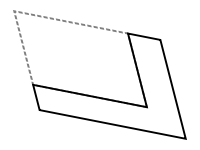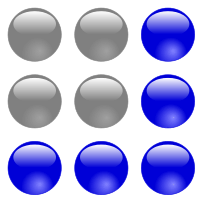gnomon
English
WOTD – 15 May 2019
Etymology
.jpg)
The gnomon (sense 1) of this sundial in Taganrog, Rostov Oblast, Russia, is shaped like a triangular blade

A gnomon in geometry (sense 3)

Four is a figurate number as it can be represented by four dots arranged in a square. The next highest square is nine. Thus, the gnomon (sense 4) between four and nine is five (represented by the blue dots).
Borrowed from French gnomon or Latin gnomon, from Ancient Greek γνώμων (gnṓmōn, “discerner, interpreter; carpenter’s square; gnomon of a sundial; (geometry) gnomon”) (or directly from the Greek word), from γιγνώσκω (gignṓskō, “to be aware of; to perceive; to know”), ultimately from Proto-Indo-European *ǵneh₃- (“to know”); the word is thus related to know.
The geometry sense (sense 3) is from the resemblance of the plane figure to a carpenter’s square.[1] Similarly, a gnomon in mathematics (sense 4) is also shaped like a carpenter’s square when depicted pictorially if the figurate numbers are squares.
Pronunciation
- (Received Pronunciation) IPA(key): /ˈnəʊmɒn/, /-mən/
- (General American) IPA(key): /ˈnoʊmɑn/, /-mən/
- Hyphenation: gno‧mon
Noun
gnomon (plural gnomons)
- An object such as a pillar or a rod that is used to tell time by the shadow it casts when the sun shines on it, especially the pointer on a sundial. [from mid 16th c.]
- 1700, Samuel Foster; William Leybourn, compiler, “[Projective Dialling: [...] The Ninth Tractate. Appendix.] Chap. IV. A General and Most Easie Way to Project Hour-lines upon All Kinds of Superfices without any Regard had to Their Standing, either in respect of Declination or Inclination”, in Dialling, Plain, Concave, Convex, Projective, Reflective, Refractive. Shewing, how to Make All such Dials, and to Adorn Them with All Useful Furniture Relating to the Course of the Sun; […], 2nd edition, London: Printed by J. Matthews, for Awnsham and John Churchill […], OCLC 316646019, page 83:
- Let a Gnomon, being firſt ſharpened into a Point, be ſhaped, and faſtned in ſuch wiſe, that it no way hinder either the draught of the Horizontal Line, or the Point of the ſhadow from having free access to the Dial at all times of the Year. […] Upon the Superfices of the Dial, obſerve the Point of the Shadow of the Gnomon (making a mark at it) and the Sun's Altitude, both of them at the ſame inſtant of time.
- 1758 March, “An Account of an Ancient Astronomical Instrument, of Immense Dimensions, lately Restored to Use”, in Sylvanus Urban [pseudonym; Edward Cave], editor, The Gentleman’s Magazine, and Historical Chronicle, volume XXVIII, London: Printed by D[avid] Henry and R. Cave, […], published January 1755, OCLC 192374019, page 99, column 1:
- The moſt celebrated gnomons, for examining the courſe of the ſun, which are exiſting at this time, have been ſuppoſed to be that in the church of St Petronio at Bologna, 89 Engliſh feet high; that of the Chartreux at Rome, about 67 feet; and that of St Sulpice at Paris, 86 feet. […] [T]he gnomon of the cathedral of that city [Florence], erected by [Paolo dal Pozzo] Toscanelli, in the courſe of the 16th century, whoſe height exceeds that of the three before-mentioned, taken all together, being near 300 Engliſh feet, and higher than our London monument by almoſt a third part.
- 1817, Brahmegupta [i.e., Brahmagupta]; Bháscara [i.e., Bhāskara I], “Shadow of a Gnomon”, in Henry Thomas Colebrooke, transl., Algebra, with Arithmetic and Mensuration, from the Sanscrit of Brahmegupta and Bháscara, London: John Murray, […], OCLC 1038133983, page 108:
- [T]he gnomon being the upright, and the shadow the side, the square-root of the sum of the squares is the hypotenuse; […]
- 1981, R. M. Batson; V. S. Reed; R. L. Tyner, “Cartographic Procedures”, in George E. Ulrich, Carroll Ann Hodges, and William R[udolf] Muehlberger, editors, Geology of the Apollo 16 Area, Central Lunar Highlands […] (Geological Survey Professional Paper; 1048), Washington, D.C.: United States Government Printing Office, OCLC 6816255, page 530:
- Approximate scales can be placed on near-field objects in pictures containing the gnomon by using an ellipse template. The Apollo 16 gnomon […] stands on three legs that, on a hard surface, define a circle 61.7 cm in diameter.
-
- An object such as a pillar used by an observer to calculate the meridian altitude of the sun (that is, the altitude of the sun when it reaches the observer's meridian), for the purpose of determining the observer's latitude.
- 1791, William Robertson, “Section II. Intercourse with India, from the Establishment of the Roman Dominion in Egypt, to the Conquest of that Kingdom by the Mahomedans”, in An Historical Disquisition Concerning the Knowledge which the Ancients had of India; […], London: Printed for A[ndrew] Strahan, and T[homas] Cadell […]; Edinburgh: E. Balfour, OCLC 1035338177, pages 78–79:
- In order to aſcertain the latitude of any place, the ancients obſerved the meridian altitude of the ſun, either by means of the ſhadow of a perpendicular gnomon, or by means of an aſtrolabe, from which it was eaſy to compute how many degrees and minutes the place of obſervation was diſtant from the Equator.
-
- The index of the hour-circle of a globe.
- (geometry) A plane figure formed by removing a parallelogram from a corner of a larger parallelogram.
- 1728, E[phraim] Chambers, “Gnomon”, in Cyclopædia: Or, An Universal Dictionary of Arts and Sciences; […] In Two Volumes, volume I (A–H), London: Printed for James and John Knapton [et al.], OCLC 951657352, page 164, column 2:
- If a Parallelogram be divided into four leſſer ones, by two Lines interſecting each other; and one of theſe Parallelograms be retrench'd, or taken away; the other three will make a Gnomon, ordinarily call'd a Square.
-
- (mathematics, by extension) A number representing the increment between two figurate numbers (“numbers equal to the numbers of dots in geometric figures formed of dots”).
- 1999, Midhat J. Gazalé, “Figurate and -adic Numbers”, in Gnomon: From Pharaohs to Fractals, Princeton, N.J.; Chichester, West Sussex: Princeton University Press, →ISBN, pages 16 and 17:
-
Translations
object used to tell time by the shadow it casts when the sun shines on it
|
|
plane figure formed by removing a parallelogram from a corner of a larger parallelogram
number representing the increment between two figurate numbers
References
- “gnomon, n.”, in OED Online

Further reading



- gnomon in The Century Dictionary, New York, N.Y.: The Century Co., 1911.
- gnomon in Webster’s Revised Unabridged Dictionary, G. & C. Merriam, 1913.
- gnomon at OneLook Dictionary Search
- “gnomon” (US) / “gnomon” (UK) in Oxford Dictionaries, Oxford University Press.
Esperanto
French
Etymology
From Latin gnomon, from Ancient Greek γνώμων (gnṓmōn, “indicator”)
Pronunciation
- IPA(key): /ɡnɔ.mɔ̃/
This article is issued from
Wiktionary.
The text is licensed under Creative
Commons - Attribution - Sharealike.
Additional terms may apply for the media files.